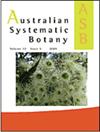Assembly and comparative analyses of the mitochondrial genome of Castanospermum australe (Papilionoideae, Leguminosae)
IF 1.6
3区 生物学
Q4 EVOLUTIONARY BIOLOGY
引用次数: 4
Abstract
Plant mitochondrial genomes are often difficult to assemble because of frequent recombination mediated by repeats. Only a few mitochondrial genomes have been characterised in subfamily Papilionoideae of Leguminosae. Here, we report the complete mitochondrial genome of Castanospermum australe A.Cunn. & C.Fraser, an important medicinal and ornamental species in the Aldinoid clade of Papilionoideae. By mapping paired-end reads, seven hypothetical subgenomic conformations were rejected and two hypothetical complete isometric mitochondrial genome conformations that differed by a 64-kb inversion were strongly supported. Quantitative assessment of repeat-spanning read pairs showed a major conformation (MC1) and a minor conformation (MC2). The complete mitochondrial genome of C. australe was, thus, generated as 542079bp in length, with a high depth of coverage (~389.7×). Annotation of this mitochondrial genome yielded 58 genes encoding 37 proteins, 18 tRNAs and three rRNAs, as well as 17 introns and three medium-sized repeats (133, 119 and 114bp). Comparison of 10 mitochondrial genomes from Papilionoideae demonstrated significant variation in genome size, structure, gene content and RNA editing sites. In addition, mitochondrial genes were shown to be potentially useful in resolving the deep relationships of Papilionoideae.澳洲栗胚(凤蝶科,豆科)线粒体基因组的组装与比较分析
植物线粒体基因组由于重复序列介导的频繁重组,往往难以组装。在豆科凤蝶亚科中,只有少数线粒体基因组被确定。在此,我们报道了Castanospermum australe A.Cunn的线粒体全基因组。凤蝶科Aldinoid分支中一个重要的药用和观赏种。通过对末端reads的定位,七个假设的亚基因组构象被拒绝,两个假设的完全等距线粒体基因组构象被强烈支持,其差异为64 kb反转。对重复跨越的读对的定量评估显示一个主要的构象(MC1)和一个次要的构象(MC2)。由此得到australe C. australe线粒体全基因组全长542079bp,覆盖深度高(~389.7 x)。该线粒体基因组的注释得到58个基因,编码37个蛋白质、18个trna和3个rnas,以及17个内含子和3个中等重复序列(133、119和114bp)。比较凤蝶科10个线粒体基因组,发现基因组大小、结构、基因含量和RNA编辑位点存在显著差异。此外,线粒体基因被证明对解决凤蝶科的深层关系有潜在的作用。
本文章由计算机程序翻译,如有差异,请以英文原文为准。
求助全文
约1分钟内获得全文
求助全文
来源期刊

Australian Systematic Botany
生物-进化生物学
CiteScore
3.10
自引率
12.50%
发文量
12
审稿时长
>12 weeks
期刊介绍:
Australian Systematic Botany is an international journal devoted to the systematics, taxonomy, and related aspects of biogeography and evolution of all algae, fungi and plants, including fossils. Descriptive taxonomic papers should normally constitute a comprehensive treatment of a group. Short papers on individual species and nomenclatural papers must contain significant new information of broader interest to be considered. The prestigious L.A.S. Johnson Review Series is published. Other review articles will also be considered. All papers are peer reviewed.
Australian Systematic Botany is published with the endorsement of the Commonwealth Scientific and Industrial Research Organisation (CSIRO) and the Australian Academy of Science.
 求助内容:
求助内容: 应助结果提醒方式:
应助结果提醒方式:


